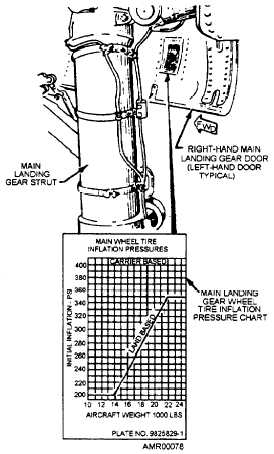Reservoir capacity
Refill level
Specification and color of fluid
Correct position of all actuating cylinders during
filling
Other information considered necessary during
the filling of the reservoir
NOTE: After opening a can of hydraulic fluid, the
entire contents should be poured into the fill stand or
servicing unit immediately. This will prevent the fluid
from absorbing dust and grit from the air. Aviation
Hydraulics Manual, NAVAIR 01-1A-l7, requires that
any remaining fluid left in the hydraulic fluid
container, after servicing a fill stand/servicing unit, be
discarded, and that the empty fluid container be
destroyed immediately and not used to store or handle
other fluids.
Q13. Define viscosity.
Q14.
What scale is used by both the Navy and the Air
Force to determine oil viscosity?
Q15. What is the military specification number for the
hydraulic fluid presently used in the hydraulic
systems of all naval aircraft?
Q16.
What should be done with the fluid remaining in
the can after filling a servicing unit?
PNEUMATIC SERVICING
Landing gear struts, hydraulic accumulators, and
various air storage bottles found on most naval aircraft
must be serviced with compressed air or nitrogen.
These components are serviced by Aviation Structural
Mechanics (AMs). You should refer to the applicable
training manuals and technical manuals for in-depth
discussions of the servicing of rate-peculiar
components.
Servicing Air Storage Bottles
Nitrogen and air storage bottles are used on some
aircraft for various emergency operations. These
bottles are necessary for the safe operation of the
aircraft and the safety of the crew. Air storage bottles
are used for such functions as emergency brakes,
emergency landing gear extension, and emergency
canopy operation. Some aircraft have a pneumatic
system that will maintain the required pressure in these
bottles while in flight. However, most of these
pneumatic systems require servicing on the ground
with an external source of high-pressure air or nitrogen
before each flight.
5-11
Air storage bottles and accumulators are serviced
similarly. Most air bottles have an air filler valve and
a pressure gauge. They usually require higher
servicing pressures than accumulators. A
high-pressure compressor and other special
equipment, such as the nitrogen booster, must be used
to obtain these higher pressures.
Inflation of Tires
For aircraft tires to perform satisfactorily, the
correct air pressure must be maintained. Aircraft tires
must be inflated to the pressure specified for the type
of operation (ashore or afloat) that the aircraft is
performing and for the gross weight of the aircraft. Air
pressure must be checked daily with an accurate
gauge. Tire inflation data is usually attached to the
aircraft, as shown in figure 5-6. When the aircraft does
not have this plate, you can find the information in the
general information and servicing section of the
applicable MIM.
Overinflation or underinflation of aircraft tires
causes specific problems. Overinflation reduces the
Figure 5-6.—Tire inflation chart.

